#Life
9 Steps To Re-opening Your Masjid Safely
Published
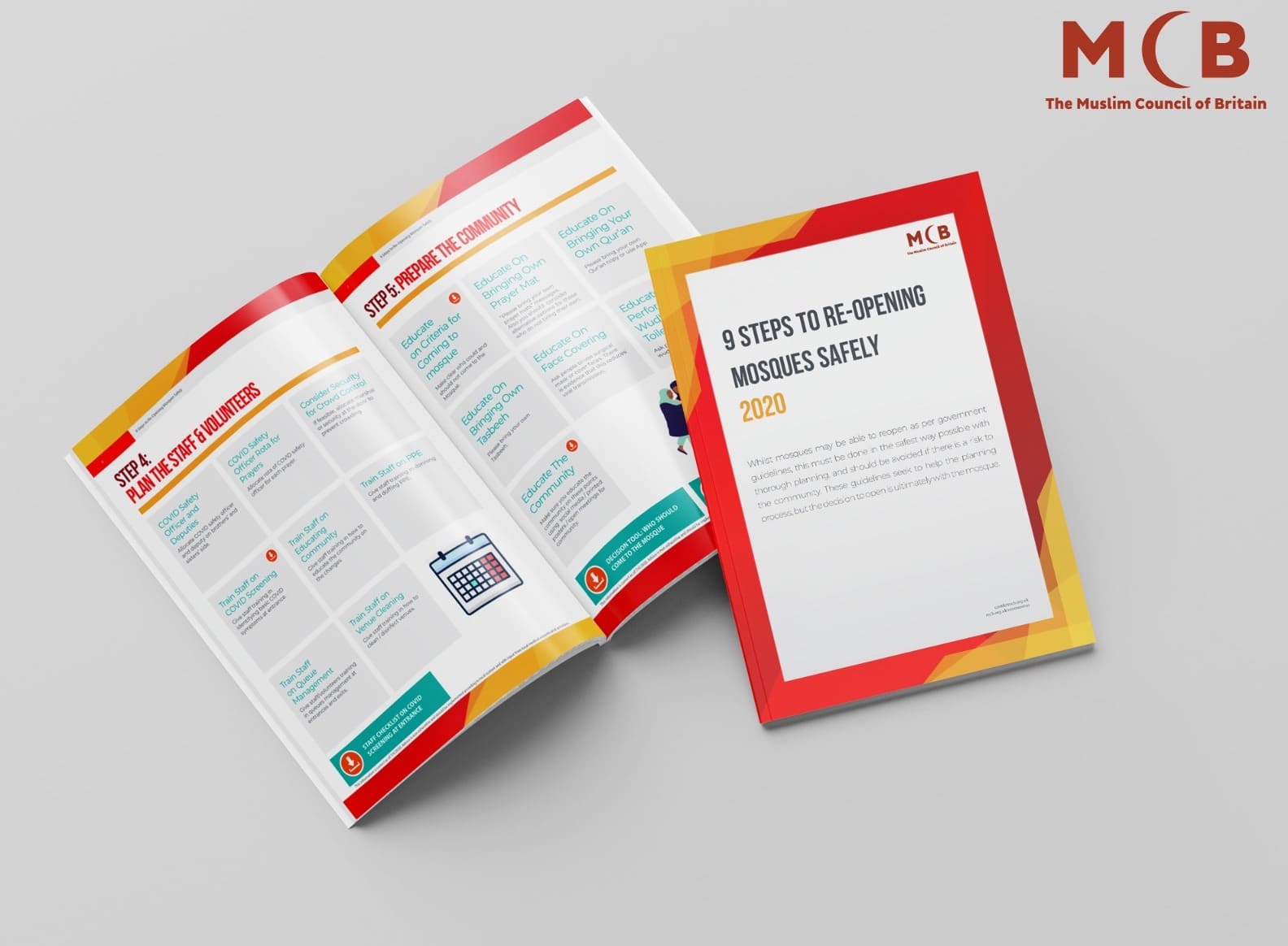
STEP 1: Plan When and How
1.1 Appoint a COVID safety officer & team – This is absolutely crucial as clear leadership and responsibility is key to ensuring the other steps work.
1.2 Get legal advice – Identify a local lawyer who will give good legal advice if and when needed.
1.3 Get medical advice – Most mosques will have at least one Muslim healthcare professional as a member of the congregation who they can refer to for medical advice.
Keep supporting MuslimMatters for the sake of Allah
Alhamdulillah, we're at over 850 supporters. Help us get to 900 supporters this month. All it takes is a small gift from a reader like you to keep us going, for just $2 / month.
The Prophet (SAW) has taught us the best of deeds are those that done consistently, even if they are small. Click here to support MuslimMatters with a monthly donation of $2 per month. Set it and collect blessings from Allah (swt) for the khayr you're supporting without thinking about it.
1.4 Get insurance advice – Speaking to your insurance company beforehand is best practice and can identify steps that they want you to take to keep your insurance valid.
1.5 Have Mosque Covid-19 policies – It is best practice to draw up policies. You can use the downloadable guides.
1.6 Undertake Risk Assessment –This is a walk through the mosque and identifying + categorising all potential risks and then identifying ways to mitigate that risk. Download an editable version here.
1.7 Make a final decision when to open – After all the above steps, a formal decision needs to be taken when to open. Do not feel rushed or pushed by those who want to go faster or what other Mosques are doing. Each mosque is different. Go at the pace that the mosque committee/board and community is ready for.
1.8 Decide how and what to open – When you decide to open, decide which aspects are going to restart and which will wait till later. Will you do Jummah only or will you do only certain prayers? It is very much up to your risk assessment and your risk appetite.
STEP 2: Plan The Space
2.1 Plan outdoors v.s. indoors – Praying outdoors is an ideal way to maximise capacity in an environment that is safer than being indoors. However, finding a suitable space that is easily available is the real challenge.
2.2 Calculate maximum safe capacity – Maintaining 2 metre (6 feet) distance between worshippers reduces risk to less than 3% compared to nearly 15% at 1 metre. What this means is that it is ideal to not just leave the space in front and either side of a worshipper empty, but also the diagonal too. You can download here.
2.3 Mark prayer spaces clearly – If you want to improve compliance with social distancing, put markings down to make it easy for the people.
2.4 Close non-essential spaces – Reduce the chance that people will hang out in meeting rooms or other communal spaces. Put up a closed sign.
2.5 Close toilets/wudhu areas – Toilets and wudhu areas are more likely to transmit infection since they involve bodily fluids in their use. A thorough clean after each use (i.e. each wudhu/ toilet use) is not practical. You can leave one toilet open for emergencies.
2.6 Ensure good ventilation – Open the windows and let the air flow as this is shown to reduce the risk of transmission in many cases.
2.7 Plan entrances & exits – Having set entrances and exits enables the smooth flow of people in and out of the building. If you assign them in advance, this will make life easier.
2.8 Plan the cleaning – There are many different types of cleaning that can be undertaken from a deep clean that may be needed after a confirmed infection in the mosque to a general surface clean between each prayer. Plan who and how this will be done to make sure the masjid is adequately cleaned.
STEP 3: Plan The Equipment
3.1 Plan equipment for the building – Print signage (click here to download), getting marking tape and consider other equipment like closed-lid pedal trash cans.
3.2 Plan public health information – Print posters giving advice on the new rules of the mosque and public health information. Can be given out as flyers or social media messages.
3.3 Plan for fundraising – A contactless card machine or a sign with the online link on which to donate to the Mosque would be ideal compared to collecting cash and coins. Check out supportourmosques.com
3.4 Plan for PPE – You’ll need to get some PPE for staff, but some Mosques may want to have a store of some available in case an attendee forgets to bring their own. Hand sanitisers would also be useful.
3.5 Plan for cleaning products – Consider what you need to do a basic or surface clean. For a deep clean, you may want to consider hiring professionals.
3.6 Plan for worshippers equipment – Educate worshippers on what they need to bring in order to get into the mosque (mainly their own prayer mat and a covering for their face, but some Mosques may request a reusable bag for their shoes etc…)
3.7 Consider medium/ long term building improvements – Some mosques may use this as an opportunity to make improvements to their building such as getting sensor taps in the toilets / Wudhu area or setting up automatic doors.
3.8 Plan for online service delivery – Many of the mosques functions will still continue online especially for those who should not be coming to the Mosque. Consider getting the equipment needed to deliver a quality online service e.g. Wi-Fi router, wireless microphone, tripod etc…
STEP 4: Plan the Space for Safety Officers and Volunteers
4.1 Train COVID safety officer & volunteers – The COVID safety officers and their teams need to know how to do their role and deal with any potential emergencies.
4.2 Set rota for COVID safety officers – It is unreasonable for one person to be on-call all day, every day. Having a rota means that at least one safety officer is on site for each prayer.
4.3 Consider volunteers for crowd control – If possible, some volunteers should deal with the managing the crowds building up outside the mosque before and after each prayer. Even one marshal could make a big difference.
4.4 Train on COVID screening – Each volunteer needs to know what they need to be looking out for when admitting people into the building. Please see attached document by clicking here.
4.5 Train on educating the community – Explain to volunteers and mosque staff on how to educate the community on the new systems in place. Lack of compliance is often not a result of rebellion, but miscommunication. Therefore ensure your team are on the same page and not making their own versions of justifications for actions.
4.6 Train on PPE – Putting on and taking off PPE requires a set process. Just like washing hands to prevent COVID isn’t a simple 2 second job, neither is removing PPE.
4.7 Train on queue management – Managing a queue is important and requires a combination of being firm and polite that ensures that people follow the rules but don’t feel patronised.
4.8 Train on cleaning – For the surface and simple cleaning, it would be ideal to explain exactly what needs cleaning and how.
STEP 5: Prepare The Community
5.1 Educate on who should come to the mosque – This is absolutely vital. If the community don’t know this information and accept it, then everything else will be an uphill struggle. Download it, read it and talk about it. Yes, it will be tough for those who should be praying at home, but even if they want to take the risk – it is not their choice to make for others. Please click here to download.
5.2 Educate on bring your own prayer mat –No prayer mat, no prayer. Carpets are known to be a fomite which can have a higher rate of transmission than normal surfaces.
5.3 Educate on bring your own Quran – Now that there are hundreds of Quran Apps on mobiles, this should be even easier.
5.4 Educate on bring your own tasbeeh/ misbaha – Again, most people have their own or better yet, use your own fingers.
5.5 Educate on face covering – Some will say this is not necessary, but there is growing evidence that it is protective especially at close quarters and especially in closed buildings. It is simple and easy to do so we would highly recommend it.
5.6 Educate on performing wudhu at home – Avoid using Wudhu facilities at the Mosque and that way prevent the spread of the infection.
5.7 Educate the community – All the above points need to be understood to be accepted and then followed. Have a plan for how you will do this. Click here for a template plan.
STEP 6: Plan The Pre-prayer
6.1 Consider pre-booking system – Having a pre-booking system for each prayer would be ideal. Some have thought about tech solutions to this, but most will struggle with this.
6.2 Plan the queues – Have (temporary) markings outside the mosque to enable socially distanced queues. This is being done outside most stores.
6.3 Plan entrances and exits – Clear separate entrances and exits are ideal. This would reduce the risk of choke points and hence transmission. Also, having entrances and exits kept open with a door stop is ideal to prevent the need for everyone to use the door handle.
6.4 Consider basic screening – It is useful having a basic screening system at the entrance to filter out those who did not know that they should not be coming to the mosque or refuse to comply with the advice. This does not need to be anything formal and should not take more than a few seconds to prevent crowding. You can download a guide to it here.
6.5 Plan a one-way system – A one way system of movement through the mosque is ideal for preventing crowding or chokepoints.
6.6 Plan on wudhu/ toilet area – Keep these areas closed and identify only one toilet to be used in case of emergency.
STEP 7: Plan For Prayers
7.1 Limit opening times – There is evidence that increased time in a closed space = potentially more exposure to the virus. Keeping opening times short discourages lingering.
7.2 Remind about sunnah at home – After the prayer, people should not attempt to sneak in a sunnah. They should go home and pray in a more safe environment.
7.3 Ensure adequate spacing – Adequate spacing means a gap in all directions and not just next to the person praying. The attached graphic gives some ideas on how to achieve this.
7.4 Leave empty row – Ideally an empty row will allow for adequate social distancing. Yes, this reduces the number of people who can fit in the prayer hall but that risk has to be weighed against the benefit of not spreading the infection in your community.
7.5 Keep khutbas and prayer short – There is a time and place for reading long surahs and delivering even longer khutbas. The mosque during a pandemic is not it.
7.6 Plan for multiple congregations – Some mosques will attempt to have multiple congregations in order to overcome the capacity challenge. This is understandable, but give yourself time to vacate the previous congregation and undertake a swift surface clean between each.
STEP 8: Plan The Post Prayer
8.1 No handshakes or socialising – The temptation will be real especially as we may not have seen each other in a while. Avoid it and do the Ertugrul hand on heart thing. I believe they call it the EyVallah.
8.2 Keep reminder/lectures online – After prayers is usually a chance to do a short reminder. Try keep these online please to avoid lingering in the prayer hall.
8.3 Ask for donations on supportourmosques.com – Many mosques are struggling with the financial hit of COVID-19. The #SupportOurMosques campaign was developed specifically to help Mosques in Britain fundraise effectively and in a united way with others. Having raised more than £400,000 something is going right so if your mosque isn’t part of it – what in the world are you waiting for?

8.4 Lock mosque between prayers – To discourage any rogue behaviour or jamaats.
8.5 Clear disposed PPE – These need to be collected in a bin near the exit and then disposed of in the proper manner.
8.6 Clean area after each prayer – As discussed previously, cleaning post each prayer should be a systematic and well organised affair.
STEP 9: Plan For Problems
9.1 Plan for if someone tests COVID +ve – Someone in the Mosque could still test COVID positive. Having a plan in place makes the whole thing a little less stressful. Download here.
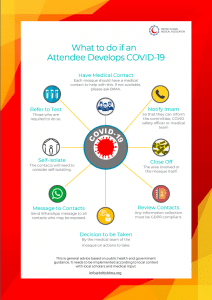
9.2 Plan for complaints – It is guaranteed that some people will think the mosque is doing too much, too little or just plain angry that they were advised to pray at home just because they are 75 years old and have more co-morbidities than the average medical text book. Having a system for dealing with complaints that is open and transparent will save you a lot of headache.
9.3 Plan for keeping authorities in the loop – Tell the local authorities including the city, police and community associations about your plans. This way they could give advice on how to adjust and they feel in the loop. They are more likely to be helpful if any issues develop.
9.4 Plan for contact tracing – If someone who prayed at the mosque was later found to be COVID +ve, then it would be ideal if there was a way to identify who was in the congregation with them so that they could be informed. This is complicated because it involves taking down personal details when people enter the mosque which has privacy, ethical and data protection implications. But at least be transparent and inform people about the information you are privy. This can save lives.
9.5 Plan for supporting those who cannot come to the mosque – For the significant chunk of the population that ideally should not be coming to the mosque, the heartache is real. It is important that we have a good plan in place to make up for the mosque sized hole in their lives through the programmes, online lectures and quizzes that we saw in the past months. Just because the Mosques are partially open, doesn’t mean our online game should be shut down.
9.6 Plan for other services – Mosques are not just places of prayer. They are places for Janazah, for marriages, for teaching Quran, for community gatherings and so much more. Having a plan for what happens with these other services would be prudent.
9.7 Plan for being fair – There are many fiqh reasons about who should be prioritised when space is limited. However, we would urge that mosques should take measures to ensure they do not reopen in a way that disadvantages women, the disabled or other segment of societies. This may create issues that are not just societal, but create divisions within society at a time that we need to avoid it like the plague. Pun intended.
9.8 Re-assess and review – Situations change quickly during a pandemic and a 2nd wave can materialise in a matter of days. Therefore, it is very important that the situation is reassessed and reviewed on a set basis to ensure that it continues to be safe.
This may seem very extensive, but hopefully it makes it easier for all those involved in reopening mosques. As mentioned earlier and throughout the document, this is generic advice and needs to be implemented according to the local context and based on advice from local authorities and medical experts. Please share any thoughts you have in the comments. May Allah help us return to the Mosques in health, happiness and unity and may He lift this pandemic from us.
To get a downloadable copy of the FULL guide, please click here:
Keep supporting MuslimMatters for the sake of Allah
Alhamdulillah, we're at over 850 supporters. Help us get to 900 supporters this month. All it takes is a small gift from a reader like you to keep us going, for just $2 / month.
The Prophet (SAW) has taught us the best of deeds are those that done consistently, even if they are small. Click here to support MuslimMatters with a monthly donation of $2 per month. Set it and collect blessings from Allah (swt) for the khayr you're supporting without thinking about it.
Dr. Muhammad Wajid Akhter - Author, interested in Islamic history, space travel and making grassroots change


Faith, Identity, And Resistance Among Black Muslim Students

Moonshot [Part 12] – November Evans

From The Prophets To Karbala: The Timeless Lessons Of Ashura For Muslims Today

Moonshot [Part 11] – The Fig Factory

Nationalism And Its Kurdish Discontents [Part II of II]: Kurds And Turkiye After Ottoman Rule

Moonshot [Part 11] – The Fig Factory

Moonshot [Part 12] – November Evans

Moonshot [Part 10] – The Marco Polo

Moonshot [Part 9] – A Religion For Real Life

Nationalism And Its Kurdish Discontents [Part II of II]: Kurds And Turkiye After Ottoman Rule

[Dhul Hijjah Series] Calling Upon the Divine: The Art of Du’a (Part 1)

IOK Ramadan 2025: Four Steps | Sh Zaid Khan

IOK Ramadan 2025: Do Your Best | Sh Zaid Khan

IOK Ramadan 2025: Giving Preference to Others | Sh Zaid Khan

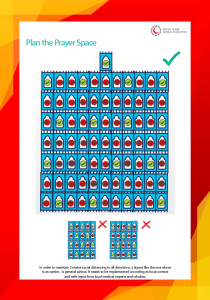

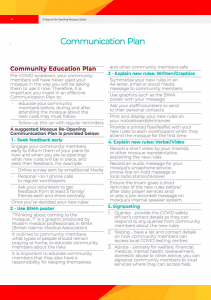
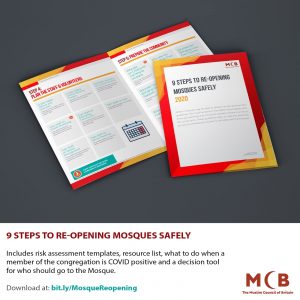




Umm Saleem
June 15, 2020 at 4:11 AM
Jazakallah Khair for this article! It is extremely detailed and contains so much beneficial information. May Allah continue to protect us all. Ameen